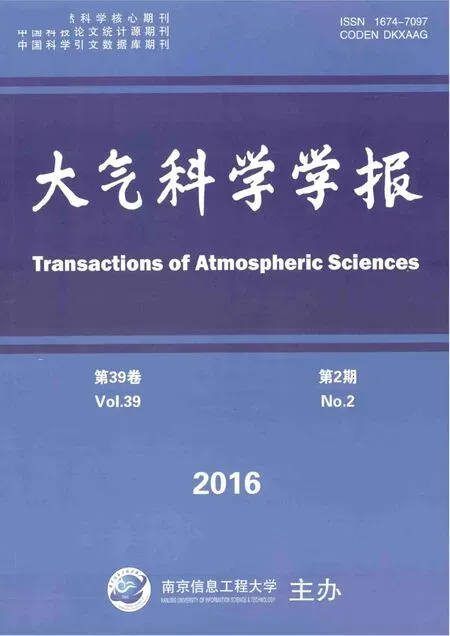西北太平洋热带云团发展与两类El Nio事件的联系
2016-10-27耿焕同黄超张伟史达伟
耿焕同,黄超,张伟,史达伟

耿焕同①②*,黄超①,张伟①,史达伟①
① 南京信息工程大学 大气科学学院,江苏 南京 210044;
② 南京信息工程大学 滨江学院,江苏 南京 210044
2014-11-06收稿,2015-12-14接受
国家自然科学基金资助项目(41201045;41430427);江苏省自然科学基金资助项目(BK20151458)
利用1982—2009年全球热带云团数据集、NCEP/NCAR再分析资料和英国Hadley中心海温资料,并引入热带云团生成率(Genesis Productivity,GP)来分析EP(Eastern Pacific)El Nio和CP(Central Pacific)El Nio事件与西北太平洋热带云团发展的相关性。研究表明,1)夏秋两季GP与Nio3指数在东南区(SE)均为显著正相关,在西南区(SW)仅秋季呈显著正相关;GP与EMI(El Nio Modoki Index)指数在夏季SE区域为显著正相关,在秋季南中国海(South China Sea,SCS)区呈负相关。2)在EP El Nio年,夏季SE区域的GP增大与低层涡度、高层散度以及低层相对湿度的相对增大一致。夏季SW区域与秋季SE区域的GP增大与有利的高低空配置相关,La Nia年则与之相反。3)在CP El Nio年,夏季SE区域的GP增大伴随着低层涡度和高层散度的增加,同时与充足的水汽及弱风切变相吻合;而秋季SCS区域的GP下降源于正涡度带、正散度带以及水汽带的东移。
西北太平洋热带云团热带气旋生成率厄尔尼诺
热带气旋的研究已经取得了显著进展,但这些研究大多集中于热带气旋生成后的移动路径和强度变化,很少关注其生成前的热带云团发展变化规律。热带云团(Tropical Cloud Cluster,TCC)是一种热带中小尺度对流系统,能将能量从海面和低层大气输送至对流层上层(Houze,1982),并在有利的环境场配合下发展成为热带气旋。对于热带气旋生成问题,尽管先后提出了强调积云对流机制的第二类条件性不稳定理论(Conditional Instability of Second Kind,CISK)以及强调海气相互作用的海气交换理论(Wind Induced Surface Heat Exchange,WISHE),但都还无法完全揭示热带气旋的生成规律(Emanuel,1986;张文龙和崔晓鹏,2013)。
TCC的发展状况会直接影响热带气旋的活动,Hennon et al.(2012)指出,相比其他大洋,西北太平洋TCC发展最为活跃,平均每年有12.4%的TCC最终发展成为热带气旋。大尺度环流场是影响TCC发展和热带气旋生成的重要因素。Gary(1968)认为对流系统很难在缺乏持续对流和低层辐合的条件下产生,并最早揭示了热带气旋生成的气候条件(26 ℃以上的海温、低层辐合、水汽输送、条件性不稳定层结和弱风切变)。此后不断有学者对此进行验证(Demaria et al.,2001;Schumacher et al.,2009)。Fu et al.(2011)的研究表明,西北太平洋TCC的扰动发展与低层涡度、散度、降水率、风切变等因素相关;Kerns and Chen(2012)则认为低层涡度与辐合、弱风切变以及低层水汽输送更有利于TCC的发展。大量观测资料显示热带气旋是由初始扰动发展而来,Chen et al.(2008)指出西北太平洋大约有71%的热带气旋由季风槽中的扰动产生。不仅如此,MJO(Maddan-Julian Oscillation)、Mixed Rossy-Gravity(MRG)波等均能触发扰动导致热带气旋生成(Dickinson and Molinari,2002;李崇银等,2012)。TCC作为一种初始扰动的产物,其产生与发展同样与季风槽、东风波、MJO、Rossby波、Kelvin波等大气系统相联系(Frank and Roundy,2006)。国内学者很早就对TCC发展过程进行了相关研究,方宗义(1982)通过分析扰动云团的高空环境场发现云团环流中心与高空大尺度辐散关系密切。
1 资料和方法
文中热带云团资料来自1982—2009年的全球热带云团数据集(Global Tropical Cloud Cluster Dataset v01r01),该数据集通过分析红外卫星资料云顶亮温数据来确定和跟踪热带云团的移动、强度等发展状况,时间分辨率为3 h,详见Hennon et al.(2011,2012);海温资料来自英国Hadley中心的1982—2009年1°×1°月平均资料(Rayner et al.,2003);热带气旋资料取自1982—2009年IBTrACS西太平洋最佳路径数据集(Knapp et al.,2010),将最大风速大于17 m/s的时间和位置定义为热带气旋生成的时间和位置。同时,台风联合预警中心(JTWC)、中国气象局、日本气象厅的热带气旋最佳路径资料也被用于对比。其他大气资料来自1982—2009年美国NCAR/NCEP的月平均资料(Kalnay et al.,1996),水平分辨率为2.5°×2.5°,垂直层共有17层。
本文引入热带云团生成率(Genesis Productivity,GP)来量化TCC发展状况,GP表示热带云团发展成热带气旋的百分比(Hennon et al.,2012),即一定时间内热带气旋的数量和TCC数量之比。
IEMI=I(SSTA)C-0.5×I(SSTA)W-0.5×I(SSTA)E。
(1)
其中:I(SSTA)C、I(SSTA)W、I(SSTA)E分别代表(165°E~140°W,10°S~10°N,)、(125°E~145°E,10°S~20°N,)、(110°W~70°W,15°S~5°N,)区域的海表温度距平。
此外,为了区分西北太平洋不同区域不同季节TCC的发展状况,以120°E和140°E作为东西边界、17°N作为南北的边界将西北太平洋分成五个部分(图1):南中国海(South China Sea,SCS)、西北区(NorthWestern,NW)、西南区(SouthWestern,SW)、东北区(NorthEastern,NE)和东南区(SouthEastern,SE)。并且对1982—2009年夏、秋两季热带云团的生成率情况分别进行统计。

图1 夏秋两季热带云团频数分布和西北太平洋分区(南中国海(SCS)、西北区(NW)、西南区(SW)、东北区(NE)、东南区(SE))Fig.1 Spatial distribution of tropical cloud cluster frequency during summer and fall(the WNP is divided into the following sub-regions:South China Sea(SCS);NorthWestern(NW) WNP;SouthWestern(SW) WNP;NorthEastern(NE) WNP;and SouthEastern(SE) WNP)
2 热带云团发展与两类El Nio事件的关系
从气候平均态来看,热带云团在西北太平洋五个子区域发展状况并不相同。由表1可知,无论夏季还是秋季SE区的GP最小,NW区的GP最大,这是因为西北太平洋的三个主要的热带气旋生成源地(南海东北部、菲律宾以东以及关岛附近)位置偏西,而SE区TCC频数较多、NW区TCC频数较少。对于整个西北太平洋(Western North Pacific,WNP)区域而言,平均GP约为9.77%,夏季GP比秋季平均每年小2%左右。

表1 1982—2009年西北太平洋及其不同区域热带云团平均生成率Table 1 The climatological GP of TCCs in the WNP and its five sub-regions during summer,fall and June to November from 1982 to 2009 %
夏、秋两季的相关系数。从表2可以看出,夏季Nio3指数在SW和SE区与GP呈显著正相关;夏季EMI指数在SE区与GP同样表现为显著正相关。这表明,EP El Nio年夏季的TCC在SW和SE区更易发展,而La Nia年则相反;同时CP El Nio年夏季SE区的GP上升。
表2热带云团生成率分别与Nio3、EMI、Nio4、Nio3.4指数的相关系数
Table 2Correlation coefficients of Nio3 index,EMI,Nio4 index and Nio3.4 index with the TCC GP in five sub-regions and the entire WNP during summer and fall

区域夏季秋季Niño3EMINiño4Niño3.4Niño3EMINiño4Niño3.4SCS0.1380.2190.4191)0.297-0.018-0.3861)-0.171-0.018NW-0.3580.128-0.154-0.238-0.1740.039-0.124-0.174SW0.5962)-0.1460.246-0.1840.0610.1350.0560.061NE-0.2850.1990.0200.176-0.1220.060-0.024-0.122SE0.4802)0.4481)0.5952)0.4351)0.5882)0.3370.5482)0.5882)WNP0.0960.3180.3180.2710.2550.0460.1800.245
注:1)表示通过95%置信度的双侧检验;2)表示通过99%置信度的双侧检验;下划线表示以TCC频数为控制变量的偏相关系数同样显著.
3 热带云团发展与两类El Nio相联系的大尺度环流因素
从850 hPa的涡度合成距平场(图2)来看,对于EP El Nio年(图2a、图2b),夏季SE区的正涡度带一直延伸至菲律宾上空,而在其北部的NE区域和西部的SCS区域均存在一个宽阔的负涡度区,致使该区域低层辐散增大。到了秋季,正涡度带东移,SCS—SW一带的负涡度区范围加大,相反NE区正涡度范围加大,辐合增强。同时,结合200 hPa散度合成距平场(图3a、图3b)后发现,夏季赤道以北的西太平洋区域高层存在一条正散度带,正好与低层正涡度带相对应。因此,夏季SE和SW区低层辐合高层辐散的高低空配置有助于TCC的对流活动增强,促进其发展。秋季SE—SCS一带正散度同样存在东移趋势,导致SW区负散度加强,高层散度在SW区产生的季节性转变抑制该区域的TCC活动。

图3 200 hPa散度(单位:10-7 s-1)合成距平场(a、c、e分别表示夏季东部型El Nio、中部型El Nio、La Nia;b、d、f分别表示秋季东部型El Nio、中部型El Nio、La Nia;阴影区表示通过95%置信度检验的区域)Fig.3 Composite of 200 hPa divergence anomalies(units:10-7 s-1) during (a,c,d)summer and (b,d,f)fall of EP El Nio,CP El Nio and La Nia years(shading indicates the statistical significance of divergence at the 95% level)
图5表示纬向风切变合成距平场。从图5a、图5b可以看出,EP El Nio夏秋两季在赤道以北西太平洋东侧的纬向风切变偏大,而在其北部存在一条风切变减弱带,这种环流配置在CP El Nio期间更为显著,但弱风切变范围更广。在La Nia年,西北太平洋中部大范围区域夏秋两季风切变减弱,但与EP El Nio年相反,位于SE区域东南侧的风切变偏大。

图4 700 hPa相对湿度(单位:%)合成距平场(a、c、e分别表示夏季东部型El Nio、中部型El Nio、La Nia;b、d、f分别表示秋季东部型El Nio、中部型El Nio、La Nia;阴影区表示通过95%置信度检验的区域)Fig.4 Composite of 700 hPa relative humidity anomalies(units:%) during (a,c,d)summer and (b,d,f)fall of EP El Nio,CP El Nio and La Nia years(shading indicates the statistical significance of relative humidity at the 95% level)

图5 纬向风垂直切变(单位:m·s-1)合成距平场(a、c、e分别表示夏季东部型El Nio、中部型El Nio、La Nia;b、d、f分别表示秋季东部型El Nio、中部型El Nio、La Nia;纬向风切变为200 hPa与850 hPa纬向风差值;阴影区表示通过95%置信度检验的区域)Fig.5 Composite of vertical zonal wind shear anomalies (units:m·s-1) during (a,c,d)summer and (b,d,f)fall of EP El Nio,CP El Nio and La Nia years(shading indicates the statistical significance of vertical zonal wind shear at the 95% level;the vertical zonal wind shear is calculated as the magnitude of the zonal wind difference between 200 hPa and 850 hPa)
3.2热带云团在风切变偏大区发展的可能原因
一般而言,弱的风切变有利于对流维持与发展,强风切变不利于对流发展。但在两类El Nio期间,SE区域存在大范围强风切变区,这与相关分析结果相矛盾。而且El Nio年Walker环流减弱会导致中东部太平洋对流增强以及西太平洋对流活动减弱(Wang et al.,2013),这与图5西北太平洋东侧风切变减弱、西侧增强是一致的。为分析高GP区域风切变偏大的原因,表3给出了GP分别与850 hPa相对涡度、200 hPa散度、700 hPa相对湿度、纬向风垂直风切变的相关系数。可见夏秋两季SE区域低层涡度和高层散度与GP的相关性都非常显著,这可能与TCC具有深厚辐合层的自身结构特征相关(Williams and Gray,1973),其对流系统的维持非常依赖高低空环境场的配合。值得注意的是夏季SE区域的GP与所有因子都呈显著正相关,这表明由于El Nio年夏季SE区域的涡度、散度以及水汽条件的配置都非常有利TCC发展,即使强风切变会抑制TCC对流活动,但GP仍然在SE区域增大。
表3热带云团生成率与850 hPa相对涡度、200 hPa散度、700 hPa相对湿度、纬向风垂直风切变的相关系数
Table 3Correlation coefficients of 850 hPa relative vorticity,200 hPa divergence,700 hPa relative humidity and vertical zonal wind shear with the TCC GP in five sub-regions during summer and fall

区域夏季秋季850hPa相对涡度200hPa散度700hPa相对湿度纬向风垂直风切变850hPa相对涡度200hPa散度700hPa相对湿度纬向风垂直风切变SCS0.2190.3350.211-0.081-0.1260.5042)0.2870.125NW-0.138-0.257-0.058-0.2960.4371)0.2650.136-0.097SW0.5222)0.109-0.2850.0030.0700.2090.0130.054NE0.013-0.108-0.021-0.0240.1680.070-0.033-0.098SE0.7222)0.5132)0.5192)0.3791)0.5662)0.6902)0.0710.109
注:1)表示通过95%置信度双侧检验;2)表示通过99%置信度双侧检验.
4 结论与讨论
2)夏季GP与EMI指数在SE区域具有显著正相关关系,而在秋季的正相关关系却并不显著,并且SCS区域的GP与EMI指数在秋季呈负相关。造成该现象的主要原因是CP El Nio年夏季SE区域的低层涡度和高层散度增加,配合充足水汽与弱风切变使得该区的GP增大,而秋季正涡度带、正散度带以及水汽带的整体东移导致了SCS区域的GP下降。
上述结论表明不同区域海温异常造成的大气环流场异常变化,是两类El Nio事件对TCC发展产生不同影响的原因。而且由于TCC自身具备的深厚辐合层的结构特点,其发展过程更为依赖有利的高低空环境场的配合(低层辐合和高层辐散)。这对进一步认识El Nio事件对TCC发展和热带气旋的生成的影响有一定的价值。当然,文中结论来自对大量观测资料的分析,因此后续还需要在数值模式实验中加以验证。
References)
Ashok K,Behera S K,Rao S A,et al.2007.El Nio Modoki and its possible teleconnection[J].J Geophys Res,112(11):C11007.
Chen G,Tam C Y.2010.Different impacts of two kinds of Pacific Ocean warming on tropical cyclone frequency over the western North Pacific[J].Geophys Res Lett,37(1):70-75.
Chen T C,Wang S Y,Yen M C,et al.2008.Are tropical cyclones less effrctively formed by easterly waves in the western North Pacific than in the North Atlantic?[J].Mon Wea Rev,136(11):4527-4540.
Demaria M,Knaff J A,Connell B H.2001.A tropical cyclone genesis parameter for the tropical Atlantic[J].Wea Forecasting,16(2):219-233.
Dickinson M,Molinari J.2002.Mixed Rossby-gravity waves and western Pacific tropical cyclogenesis.Part I:Synopic evolution[J].J Atmos Sci,59(14):2183-2196.
Emanuel K A.1986.An air-sea interaction theory for tropical cyclones.Part I:Steady-state maintenance[J].J Atmos Sci,43(6):585-605.
方宗义.1982.台风发生发展过程中的云型特征与高空环境流场的关系[J].大气科学,6(3):274-282.Fang Z Y.1982.The relationship between the cloud pattern and the environmental flow pattern of the upper troposphere during the genesis and development of typhoon[J].Chinese J Atmos Sci,6(3):274-282.(in Chinese).
Frank W M,Roundy P E.2006.The role of tropical waves in tropical cyclogenesis[J].Mon Wea Rev,134(9):2397-2417.
Fu B,Peng M S,Li T,et al.2011.Developing versus nondeveloping disturbances for tropical cyclone formation.Part II:Western North Pacific[J].Mon Wea Rev,140(4):1067-1080.
Gray W M.1968.Global view of the origin of tropical disturbances and stroms[J].Mon Wea Rev,96(10):669-700.
Hennon C C,Helms C N,Knapp K R,et al.2011.An objective algorithm for detecting and tracking tropical cloud clusters:Implications for tropical cyclogenesis prediction[J].J Atmos Oceanic Technol,28(8):1007-1018.
Hennon C C,Papin P P,Zarzar C M,et al.2012.Tropical cloud cluster climatology,variability,and genesis productivity[J].J Climate,26(10):3046-3066.
Houze J R A.1982.Cloud clusters and large-scale vertical motions in the tropics[J].J Meteor Soc Japan,60(1):396-410.
Kalnay E,Kanamitsu M,Kistler R,et al.1996.The NCEP/NCAR 40-year reanalysis project[J].Bull Amer Meteor Soc,77(3):437-471.
Kao H Y,Yu J Y.2009.Contrasting eastern Pacific and central Pacific types of ENSO[J].J Climate,22(3):615-631.
Kerns B W,Chen S S.2012.Cloud clusters and tropical cyclogenesis:Developing and nondeveloping systems and their large-scale environment[J].Mon Wea Rev,141(1):192-210.
Kim H M,Webster P J,Curry J A.2011.Modulation of North Pacific tropical cyclone activity by three phases of ENSO[J].J Climate,24(6):1839-1849.
Knapp K R,Kruk M C,Levinson D H,et al.2010.The international best track archive for climate stewardship (IBTrACS):Unifying tropical cyclone best track data[J].Bull Amer Meteor Soc,91(3):363-376.
李崇银,潘静,田华,等.2012.西北太平洋台风活动与大气季节内振荡[J].气象,38(1):1-16.Li C Y,Pan J,Tian H,et al.2012.Typhoon activities over the western North Pacific and atmospheric intraseasonal oscillation[J].Meteor Mon,38(1):1-16.(in Chinese).
秦坚肇,王亚非.2014.构建描述两种ENSO类型的新指数[J].气象学报,72(3):526-541.Qing J Z,Wang Y F.2014.Construction of new indices for the two types of ENSO events[J].Acta Meteorologica Sinica,72(3):526-541.(in Chinese).
Rayner N A,Parker D E,Horton E B,et al.2003.Global analyses of sea surface temperature,sea ice,and night marine air temperature since the late nineteenth century[J].J Geophys Res,108(D14):1063-1082.
Schumacher A B,DeMaria M,Knaff J A.2009.Objective estimation of the 24-h probability of tropical cyclone formation[J].Wea Forecasting,24(2):456-471.
Smith T M,Reynolds R W,Peterson T C,et al.2008.Improvements to NOAA’s historical merged land—ocean surface temperature analysis (1880—2006) [J].J Climate,21(10):2283-2296.
陶丽,靳甜甜,濮梅娟,等.2013.西北太平洋热带气旋气候变化的若干研究进展[J].大气科学学报,36(4):504-512.Tao L,Jin T T,Pu M J,et al.2013.Review of the researches on climatological variations of tropical cyclones over western North Pacific[J].Trans Atmos Sci,36(4):504-541.(in Chinese).
Wang B,Chan J C L.2002.How strong ENSO events affect tropical storm activity over the western North Pacific[J].J Climate,15(13):1643-1658.
Wang C,Li C,Mu M,et al.2013.Seasonal modulations of different impacts of two types of ENSO events on tropical cyclone activity in the western North Pacific[J].Climate Dyn,40(11/12):2887-2902.
Williams K T,Gray W M.1973.Statistical analysis of satellite-observed trade wind cloud clusters in the western North Pacific[J].Tellus,25(4):313-336.
张文龙,崔晓鹏.2013.热带气旋生成问题研究综述[J].热带气象学报,29(2):337-346.Zhang W L,Cui X P.2013.Review of the studies on tropical cyclone genesis[J].J Trop Meteor,29(2):337-346.(in Chinese).
张颖,王会军.2010.全球变暖情景下西北太平洋地区台风活动背景场气候变化的预估[J].气象学报,68(4):539-549.Zhang Y,Wang H J.2010.A projection of future climate change over the western North Pacific related to typhoon activities[J].Acta Meteorologica Sinica,68(4):539-549.(in Chinese).
In order to improve the accuracy of tropical cyclogenesis forecasting,it is vitally important to study how Tropical Cloud Clusters(TCCs) develop into Tropical Cyclones(TCs),and the related climatic characteristics.TC genesis is poorly understood,since most previous studies have focused on the time after genesis.In the present study,global tropical cloud cluster data,NCEP/NCAR reanalysis data,Hadley Centre sea surface temperature data,and Genesis Productivity(GP) data (representing the ratio of TCCs that develop into TCs) were used to analyze the different impacts of two El Nio types on the evolution of TCCs in the Western North Pacific (WNP) from 1982 to 2009.The results indicate that GP is significantly and positively correlated with the Nio3 index in the southeastern sub-region of the WNP during summer.During fall,GP is significantly and positively correlated with the Nio3 index in the southwestern and southeastern sub-regions.The El Nio Modoki Index(EMI) has a markedly positive(negative) correlation with GP in the southeastern(South China Sea) sub-region during summer(fall).All these results are consistent with the large-scale environmental flow that affects TCC activity.Eastern Pacific(EP) El Nio events are associated with a significant increase in 850 hPa relative vorticity,200 hPa divergence and 700 hPa relative humidity in the southeastern sub-region during summer.The increase of GP in the southwestern sub-region during fall occurs because the relative vorticity and divergence are favorable for TCCs in EP El Nio years,whereas the opposite situation occurs during La Nia years.Central Pacific(CP) El Nio events enhance(suppress) GP in the southeastern sub-region(South China Sea) during summer(fall) because relative vorticity,divergence,relative humidity and vertical zonal wind shear are favorable(unfavorable) for the development of TCCs.In summary,the large-scale environmental flow anomalies,caused by El Nio events,create distinct effects on TCC activity in the WNP.Positive feedback is produced by CP El Nio events and EP El Nio events in the southeastern sub-region,but the effects of the two El Nio types are completely different in the southwestern sub-region and South China Sea.After comparing the different impacts of the two El Nio types on TCC activity,it was found that the changes in large-scale environmental factors produce different feedback effects on the development of TCCs in the WNP.Specifically,it is in the eastern part of the WNP that EP El Nio events affect TCC activity,but for CP El Nio events the impacts on the evolution of TCCs spread to the South China Sea.And it is in the South China Sea that the influences of the two El Nio types on TCCs are opposite.
Western North Pacific;tropical cloud cluster;tropical cyclone;genesis productivity;El Nio
(责任编辑:孙宁)
Relationship between the development of tropical cloud clusters and two El Nio types over the Western North Pacific
GENG Huantong1,2,HUANG Chao1,ZHANG Wei1,SHI Dawei1
1SchoolofAtmosphericScience,NanjingUniversityofInformationScience&Technology,Nanjing210044,China;2BinjiangCollege,NanjingUniversityofInformationScience&Technology,Nanjing210044,China
10.13878/j.cnki.dqkxxb.20141106002
*联系人,E-mail:htgeng@nuist.edu.cn
引用格式:耿焕同,黄超,张伟,等.2016.西北太平洋热带云团发展与两类El Nio事件的联系[J].大气科学学报,39(2):189-197.
Geng H T,Huang C,Zhang W,et al.2016.Relationship between the development of tropical cloud clusters and two El Nio types over the Western North Pacific[J].Trans Atmos Sci,39(2):189-197.doi:10.13878/j.cnki.dqkxxb.20141106002.(in Chinese).
